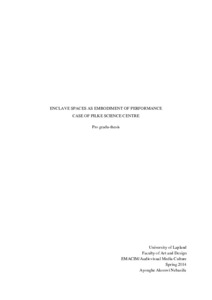Enclave spaces as embodiment of performance: case of Pilke science centre
Ayonghe, Akonwi Nebasifu (2014)
Ayonghe, Akonwi Nebasifu
Lapin yliopisto
2014
openAccess
Julkaisun pysyvä osoite on
https://urn.fi/URN:NBN:fi:ula-201401161004
https://urn.fi/URN:NBN:fi:ula-201401161004
Tiivistelmä
This study aims to describe how the display of objects and technologized materials in a typical enclave space is vital to enhancing modes of performances. My specific objectives cut across concepts of norms, display mode, performance, and visitor experiences. I regard enclave space as encompassing pre-determined norms, use of signs that tend to control behavioural patterns of visitors. The study uses background knowledge on relevant studies in cultural, media, and tourism research to argue that emphases have often been on humanistic aspects of performance in touristic spaces. I then focus on non-humanistic part of interactivity as regarding objects, using a case of the Pilke Science Centre in Rovaniemi, with a survey of international student-participants and a mixed-method approach to collect data.
Results show a variety in findings, some of which indentify display modes of objects, specifically the norms they embody that construct spaces by being instructive, reflexive, or informative to visitors. I identify performative modes as greatly influenced by object display and use of norms; ranging from body poses to screen-mediated photography, among others. Results equally highlight experiences and consumer-choices of participants interacting with objects. New in the findings, is a six-concept interactive space model to argue a three-way communication process between the object, visitor, and experience created in the space.
My research concludes with the viewpoint that Objects are in essence an embodiment of constructs and performative practices enhanced by their display mode, level expression, and norms.
Results show a variety in findings, some of which indentify display modes of objects, specifically the norms they embody that construct spaces by being instructive, reflexive, or informative to visitors. I identify performative modes as greatly influenced by object display and use of norms; ranging from body poses to screen-mediated photography, among others. Results equally highlight experiences and consumer-choices of participants interacting with objects. New in the findings, is a six-concept interactive space model to argue a three-way communication process between the object, visitor, and experience created in the space.
My research concludes with the viewpoint that Objects are in essence an embodiment of constructs and performative practices enhanced by their display mode, level expression, and norms.
Kokoelmat
- Pro gradu -tutkielmat [4873]
